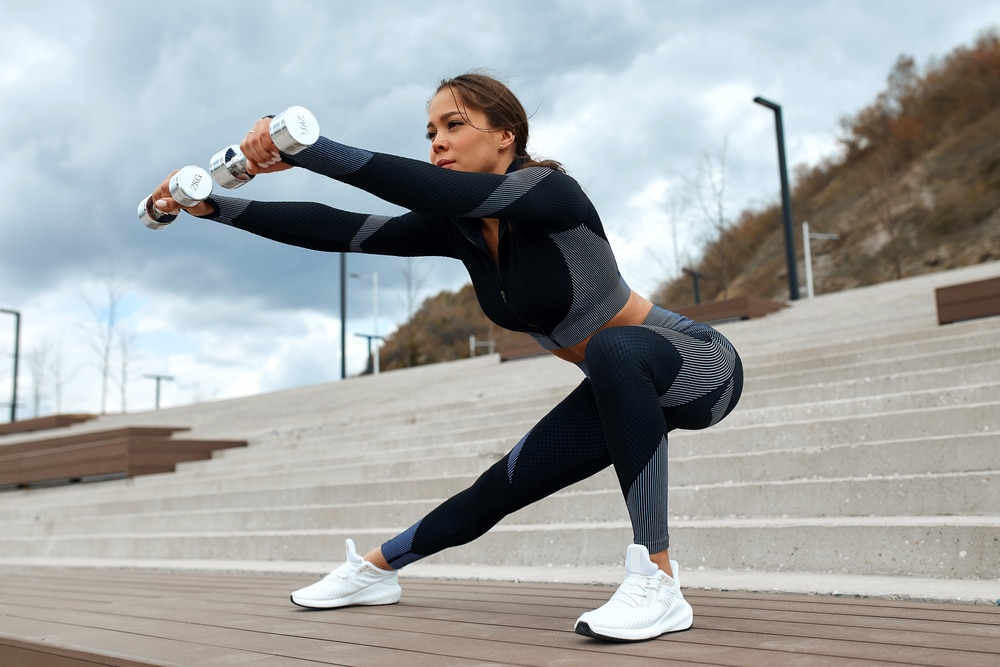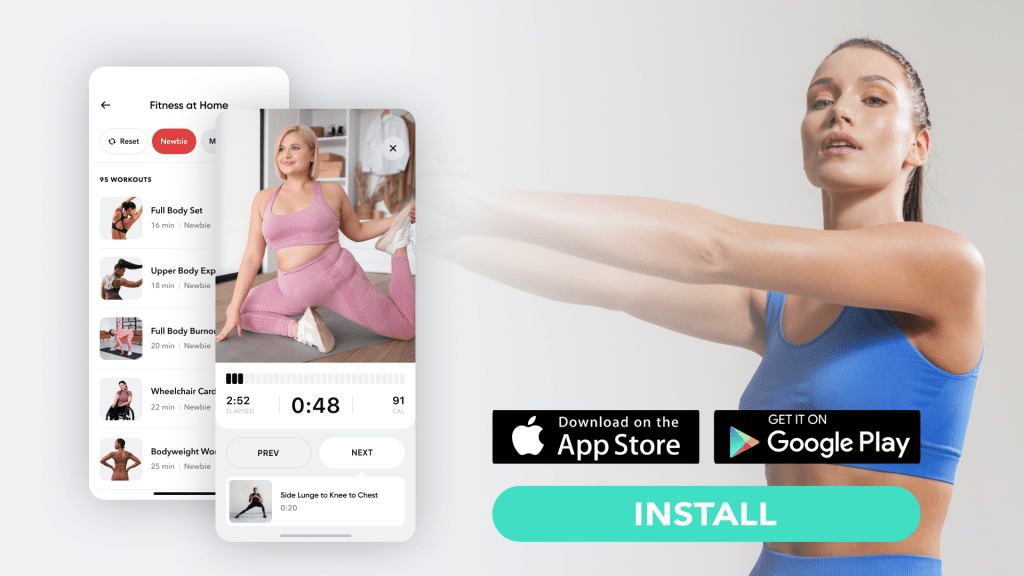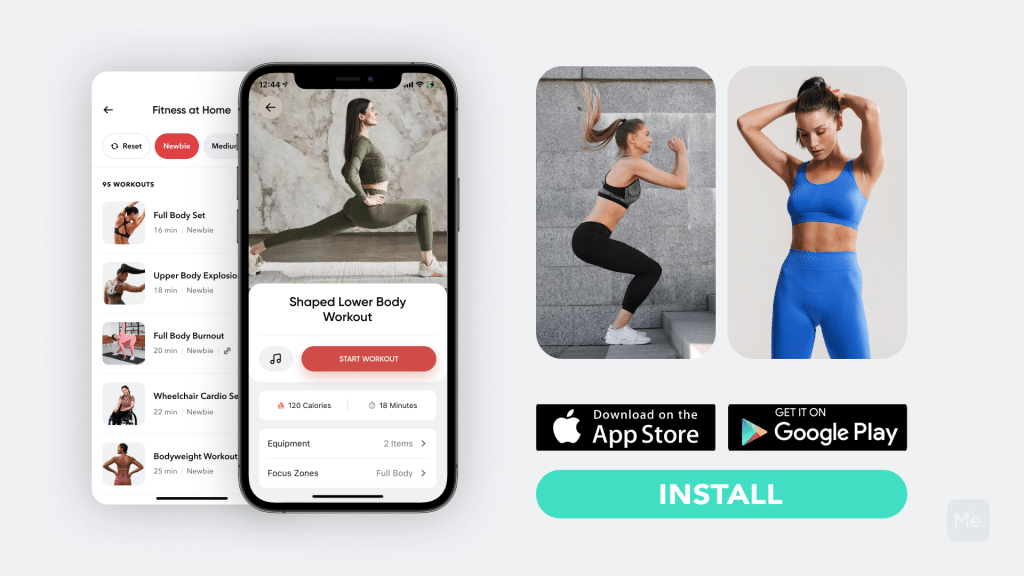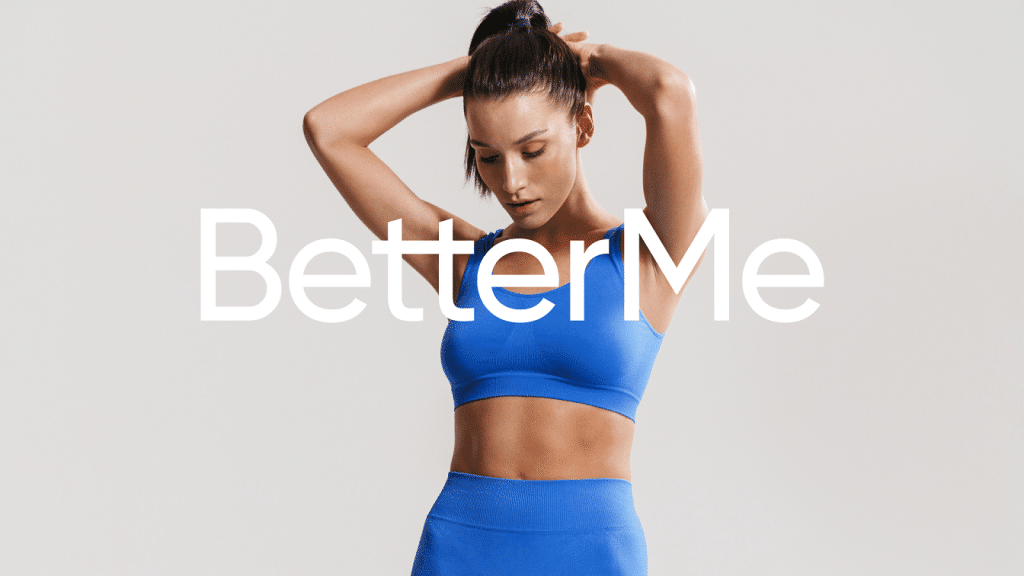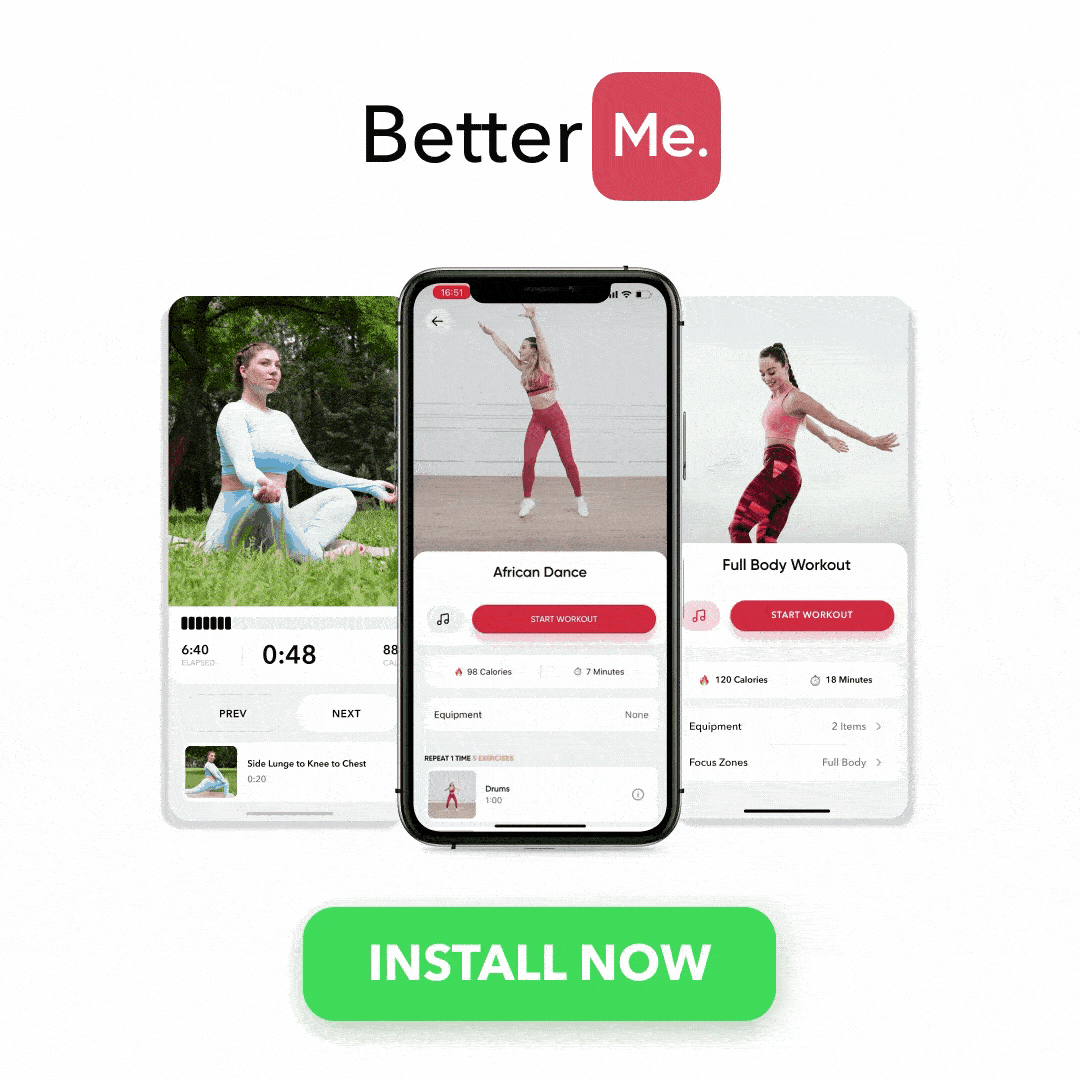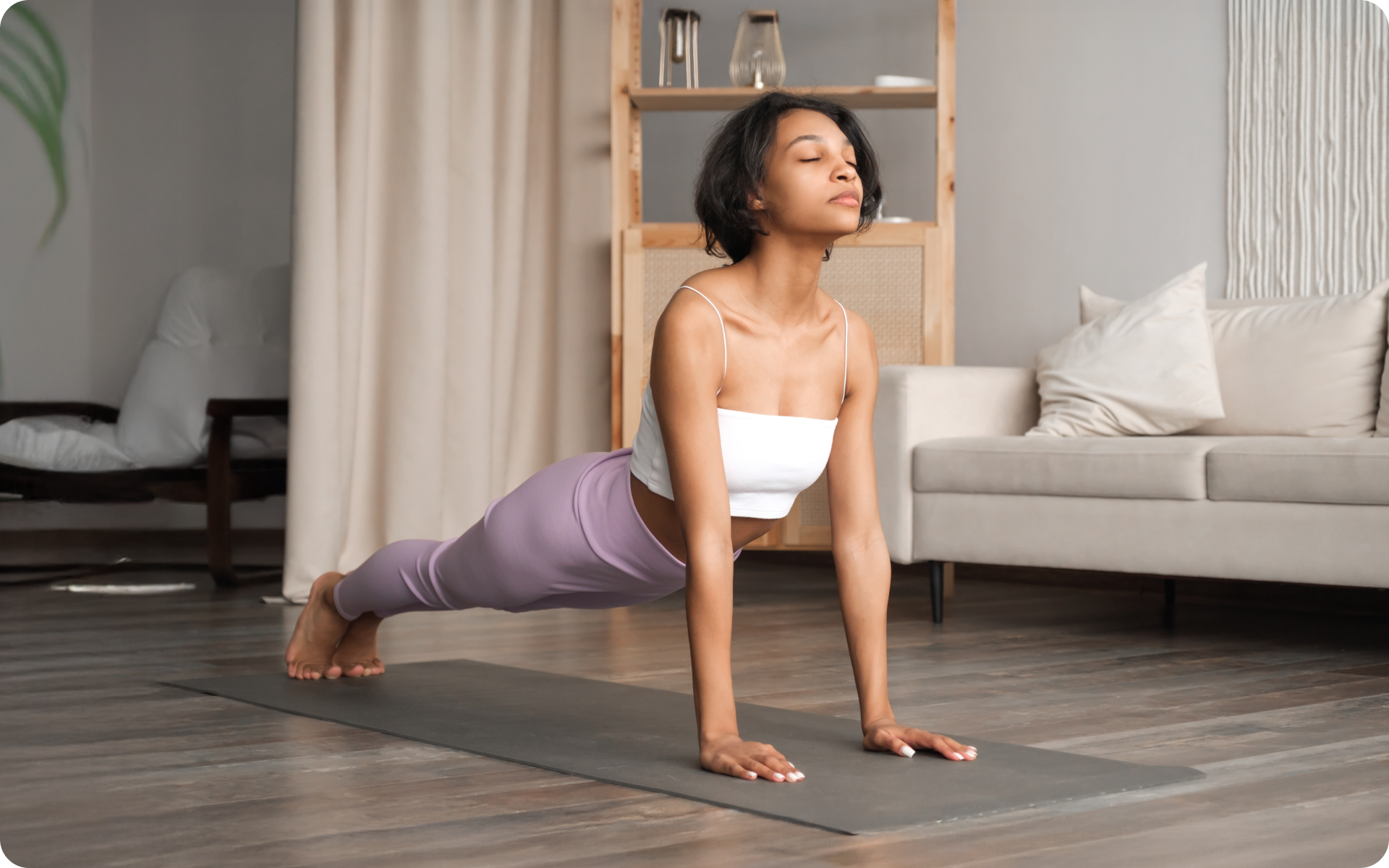Regardless of how you feel about them, squats are a game-changer for many people. They work to tone your legs, glutes, and core. Additionally, they are an example of a functional exercise, meaning they train your body muscles for better performance of daily activities. Luckily, you have endless squat variations, thanks to their versatility. Some of the commonly performed squats are the dumbbell squat variations. Check out our compilation of the top dumbbell squat variations to elevate your squatting game.
Is Squatting With Dumbbells Effective?
The squat is a classic exercise that you will likely encounter in many, if not all, exercise programs. Whether at beginner or advanced levels, you are bound to find this movement presented in different variations, due to its effectiveness in building lower body strength.
Because of how explosive and effective this exercise is without any equipment, many people often question how effective dumbbell squat variations are. After all, the use of dumbbells risks messing up your balance and coordination. So are these exercises worth it?
Indeed they are! Most evidence shows that dumbbells increase the intensity of your squat and help work your muscles further. As a result of this training your muscles can develop to their fullest extent (1).
Can Dumbbell Squats Build Muscle?
Yes, they can. You can reap all the benefits of doing squats, regardless of the variation you choose. These include building muscle mass and strength, improving your stability, coordination, and lower body strength (1).
It is crucial to focus on learning the proper form of a squat before incorporating dumbbells. Once you have that down pat, proceed to get comfortable holding dumbbells while squatting, as it will highly impact your squatting form.
Read More: 6 Week Squat Program: The Ultimate Guide For Toning Your Lower Body
What Is The Proper Squat Form?
To perfect the basic squat technique before trying any squat variation or incorporating weights do this (3):
- Stand upright with your feet at a shoulder-width distance, back straight, and arms resting straight down at your sides.
- Inhale, tighten your core, and push your hips back while bending your knees to assume a sitting stance. All along, keep your back straight and activate your abdominal muscles.
- Lower until your thighs are parallel to the floor or until your point of comfort. All the while keep your chest up and face gazing forward.
- Push through your entire foot to the starting position.
- Clench your glutes at the top to activate them, then repeat to perform another rep.
Different Dumbbell Squat Variations You Ought To Add To Your Workout Plan
You will not find a trainer who has not incorporated bodyweight squats or squat variations in their workout plans. Thanks to their loads of benefits, they are pretty much a staple in any exercise program.
Over time, you may perform the regular squat effortlessly, regardless of the reps or sets you perform. When this happens we all know that it is time to upgrade.
If you are among such people, here are some excellent squat variations to add to your workout plan and fire up your glutes and core!
Dumbbell Front Squats
Although dumbbell front squats and goblet squats are often used interchangeably, the two are different exercises. The difference lies in their form and the kind of dumbbells used. In a goblet squat, you are asked to hold one dumbbell in the center of your chest. However, for a dumbbell front squat, you must hold two dumbbells (3).
-
How To Perform A Dumbbell Front Squat
Here is a comprehensive guide on how to perform a dumbbell front squat correctly (3):
- Stand upright with your feet at a shoulder-width distance while holding a dumbbell of comfortable weight in each hand and in front of your chest. Make sure your palms are facing your body.
- Keeping your neck and spine neutral, push your hips back while pushing your knees outward as if you are taking a seat. Make sure your knees are aligned with your toes.
- Squat until your hips are below your knees or to your point of comfort.
- Push through your heels to return to the starting position.
- Clench your glutes at the top of the movement and repeat.
If you’ve mustered up the courage to crush your weight loss goal, let Betterme take the sting out of this demanding process. Our app will help you restructure your habits, remold your life and crank up your fitness results!
Goblet Squats
Goblet squats are a staple in most full-body workouts due to their excellence in building body muscle and developing cardiovascular fitness. They are the go-to exercise when you need to develop extra strength in your quads.
This is also an excellent squat progression from air squats. That is mainly for beginners because it adds resistance while simultaneously helping you focus on the correct form. Although it targets all major muscle groups, it primarily works your lower body muscles, including glutes, quads, hamstrings, and calves (4).
-
How Do You Do Goblet Squats?
As mentioned earlier, you perform goblet squats with dumbbells using one dumbbell. Here are the exercise instructions:
- Stand with your feet slightly wider than hip-width distance and toes pointing slightly outward.
- Hold a dumbbell in both hands, then bend your elbows, so it is positioned right at the center of your chest.
- Remember to tighten your core, gaze straight ahead, and keep your back straight.
- Push your hips back, inhale, and slowly bend your knees to perform a squat. Keep the dumbbell close to your body during the movement.
- Squat until your hips are parallel with your knees. Keep your chest tall, back straight, and your body weight evenly distributed or slightly more toward your heels.
- Exhale and press through your heels to return to the starting position. Engage your glutes at the top and repeat.
Plié Squat
The dumbbell plié squat is a variation of the goblet squat. It is mainly used to strengthen the leg muscles due to its effectiveness in working the lower body. However, it primarily works the quads (1).
It is an excellent squat variation that beginners can use to learn the correct squat form. Additionally, it can help beginners progress to more advanced variations that require heavier weights.
-
Plié Squat Instructions
Here are the steps to take to perform this exercise (1):
- Select a dumbbell and place it on end on the floor.
- Stand with your feet wider than shoulder-width distance with your arms hanging by your sides.
- Squat by pushing your hips back until your thighs are parallel to the floor, then grab the edges of the dumbbell with both hands.
- Tighten your core, and then drive into your feet to stand tall.
- Clench your glutes, then slowly lower back to the starting position and repeat.
Wide Leg Sumo Squats
These squat variations are performed with your legs wider than shoulder-width stance. The wide stance increases the work on your hamstrings, glutes, and adductors while still targeting your core, quads, and other upper body muscles (3). To perform them:
- Hold a dumbbell with both hands and stand upright. Position your feet wider than shoulder-width distance with your knees slightly bent. Similarly, position your arms by your sides and toes facing out. This marks the starting stance.
- Inhale, bend your knees, push your hips back, and lower your legs until your thighs are parallel to the floor.
- Press primarily with the heel of your foot to return to the starting position. Remember to exhale.
- Repeat.
Overhead Squat With Dumbbells
An overhead squat with dumbbells is more challenging because it demands more stability, flexibility, and mobility than a regular squat. Although it targets your entire body, it primarily works your quads, hamstrings, calves, and glutes (2). Below is the step by step instructions on how to perform an overhead squat with dumbbells:
- Start in a standing stance with your feet slightly wider than shoulder-width apart. Keep your back straight, and toes pointed out.
- Hold a pair of dumbbells over your head with a wide grip.
- Breathe in, keep your chest up, then slowly sit back into your hips as if to sit. Squat until your thighs are slightly past parallel to the ground or until your point of comfort.
- While at the bottom of the movement, stretch your arms overhead so that the weights face the ceiling. Your shoulder blades must be squeezed together and your arms locked in place at this stance. Keep your head poking through your arms to keep the dumbbells aligned with your shoulders, hips, and heels.
- Lower the weights to the starting position while driving through your heels to return to the starting stance.
- Repeat.
Read More: 90 Days Squat Challenge: Tone Your Lower Body With This Workout Routine
Bulgarian Split Squat
The Bulgarian split squat is considered the most challenging squat variation by most people because, for one, you are performing it when your back foot is elevated. Additionally, it requires more balance and stability. Unfortunately, a lot of people struggle with their foot placement, so they say this variation is the hardest (3).
However, all you have to do is learn the correct form and foot placement. For example, some people prefer a relatively narrow stance, while others like to fully stretch out their back leg (3). That said, it more or less comes down to your preference and comfort.
You should never place your back foot directly behind your front foot. That makes balancing a problem, which may cause you to trip several times.
-
How To Master A Bulgarian Split Squat
So, here is the correct procedure to follow to ace the Bulgarian split squat with dumbbells (1):
- Grab a comfortable dumbbell in each hand, place your front foot in position, and lean forward. Position the weights between your hips and your forward foot. After that, lift your back foot and rest it on a bench or elevated surface.
- While keeping your back straight and neck neutral, inhale and slowly lower into a squatting position by bending your knees and pushing your hips toward the ground.
- You will feel as if most of your body weight is on your forward foot and your rear foot is helping with balance.
- Keep lowering until your rear knee nearly touches the ground, or your back starts to arch. However, it should not arch because this is injurious.
- Drive through your front foot to push off the ground and clench your glutes while in the standing stance.
- Repeat all the reps, then switch legs.
Dumbbell Pistol Squat
Pistol squats are helpful mainly for athletes because they build lower body strength and enhance functional training. They also build core strength and work different muscle groups like your quad, calves, hamstrings, and hip adductors (4).
Although they are a great addition to any workout plan, they are not advised for beginners or individuals with back issues. So check in with your doctor and trainer before adding the move to your regime. Here is a guide on how to perform dumbbell pistol squats:
- Start in a standing position while holding a dumbbell upright in both hands and close to your chest.
- Raise either foot an inch or two off the ground. Keep your chest up, back straight, knees and hips slightly bent, and face looking directly forward.
- Descend into a squat by bending your knees and pushing your hips back. As you lower yourself, the leg you lifted off the floor will slowly rise towards the ceiling. Be sure to descend gradually because a quick pace disrupts your balance, and you may fall on either side.
- While at the bottom of the movement, pause for a few seconds. After that, slowly extend the hips and knee of the leg pressed on the floor to return to stand. Make sure you drive through its heel to return to the starting position.
- Repeat until you complete the desired number of repetitions before switching legs.
Reasons why BetterMe is a safe bet: a wide range of calorie-blasting workouts, finger-licking recipes, 24/7 support, challenges that’ll keep you on your best game, and that just scratches the surface! Start using our app and watch the magic happen.
Common Mistakes To Watch Out For When Performing These Squat Variations
The only way you will reap the most from these variations is if you perform them correctly. The correct technique also reduces injury risk. Here are the most common mistakes to watch out for and avoid in these squat variations (4):
- Holding Your Breath. As seen in all these exercises, you must inhale when squatting and exhale when standing.
- Caving In Your Knees. Your knees must always be falling out.
- Leading with Your Knees. Your hips must always lead your squat.
- Not Engaging Your Core. Tighten your core throughout the movement because it is the foundation of this exercise.
The Bottom Line
The regular squat exercise is a highly versatile compound movement that can improve your lower body strength and functionality of daily activities. Additionally, it can increase your stability and core strength.
You can incorporate different dumbbell squat variations into your program for added benefits and intensity. Every squat variation listed here works your muscles differently but helps you reap the named squat benefits. Make sure you talk to your doctor and trainer before making any changes to your workout plan.
DISCLAIMER:
This article is intended for general informational purposes only and does not serve to address individual circumstances. It is not a substitute for professional advice or help and should not be relied on for making any kind of decision-making. Any action taken as a direct or indirect result of the information in this article is entirely at your own risk and is your sole responsibility.
BetterMe, its content staff, and its medical advisors accept no responsibility for inaccuracies, errors, misstatements, inconsistencies, or omissions and specifically disclaim any liability, loss or risk, personal, professional or otherwise, which may be incurred as a consequence, directly or indirectly, of the use and/or application of any content.
You should always seek the advice of your physician or other qualified health provider with any questions you may have regarding a medical condition or your specific situation. Never disregard professional medical advice or delay seeking it because of BetterMe content. If you suspect or think you may have a medical emergency, call your doctor.
SOURCES:
- Does the Dumbbell-Carrying Position Change the Muscle Activity in Split Squats and Walking Lunges? (2015, ncbi.nlm.nih.gov)
- Fitness (2021, mayoclinic.org)
- How to squat? Effects of various stance widths, foot placement angles and level of experience on knee, hip and trunk motion and loading (2018, ncbi.nlm.nih.gov)
- Trunk muscle activity during different types of low weighted squat exercises in normal and forefoot standing conditions (2021, pubmed.ncbi.nlm.nih.gov)
